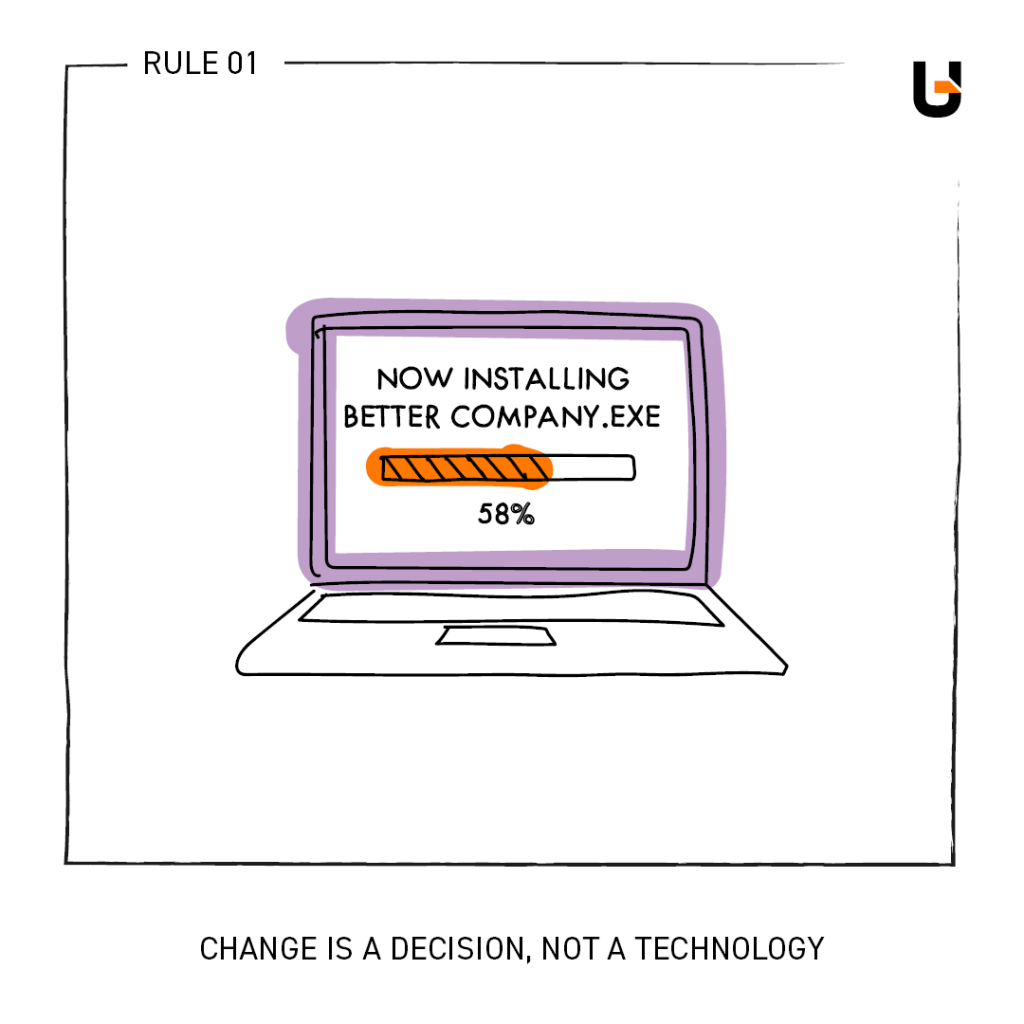10 Critical Digital Transformation Challenges to Overcome
Digital transformation has become a strategic imperative for organizations aiming to stay competitive and relevant in today’s rapidly evolving business landscape. However, the journey towards digital transformation is fraught with challenges that demand careful navigation. Successfully overcoming these obstacles is crucial for organizations to harness the full potential of digital technologies and realize their business objectives.
Today, some companies may even be feeling some pressure to digitize. After all, that’s what customers expect, that’s what they observe in the competition, and that’s what market trends indicate. But it’s worth remembering that digitization is best done at one’s own pace, with the help of a partner who can help identify potential ice floes safely leading to the exciting harbor of digitization.
10 main digital transformation challenges you need to discover:
- Company’s Cultural Resistance to Change
- Talent Shortages and Skill Gaps
- Legacy Systems Integration
- Data Security and Privacy Concerns
- Customer Experience Transformation
- Agility and Speed of Implementation
- Cost Management and Return on Investment (ROI)
- Regulatory Compliance
- Operational Challenges
- Sustainability and Environmental Impact
1 / Company’s Cultural Resistance to Change
One of the foremost challenges in digital transformation journey is the resistance to change within organizational culture. Employees and leadership must be aligned with the digital vision, fostering a mindset that embraces innovation and continuous learning.
Cultural resistance is more than just a few disgruntled employees; it’s an ingrained mindset that resists the unfamiliar. Employees may fear the unknown, worry about job security, or simply be comfortable with the routines they’ve known for years. Convincing them that the digital revolution is not a threat but an opportunity is crucial.
The Solution
Effective communication is the bridge between resistance and acceptance. Transparently communicate the reasons behind the transformation, the benefits it brings, and the support available. Engage in open dialogues, addressing concerns and answering questions to demystify the digital transformation process.
Resistance often stems from a lack of understanding or fear of incompetence in the face of new technologies. Providing comprehensive training programs and upskilling initiatives not only build confidence but also empower employees to actively contribute to the digital journey.

2 / Talent Shortages and Skill Gaps
In the grand digital transformation stage, having the right performers is crucial. Unfortunately, many organizations face the daunting challenge of talent shortages and skill gaps in the ever-evolving landscape of digital technologies.
The demand for digital skills often outpaces the available talent pool. Organizations face the challenge of recruiting, retaining, and upskilling employees with the necessary expertise in areas such as data analytics, artificial intelligence, and cybersecurity.
The Solution
Organizations need to become talent incubators. Investing in continuous training and development of digital transformation programs ensures that employees are equipped with the latest digital skills. This could involve partnerships with educational institutions, online courses, or in-house training programs. Encourage employees to pursue certifications, attend workshops, and engage in self-directed learning. This not only benefits the company but also empowers individuals to stay relevant in the digital landscape.
Also not all talent needs to be full-time employees. Embracing a flexible workforce model that includes freelancers, consultants, and part-time experts empowers organizations to access a rich and varied reservoir of digital expertise precisely when required.
3 / Legacy Systems Integration
Organizations often find themselves wrestling with the complexities of integrating new digital technologies with existing legacy systems. This clash of old and new can be a stumbling block on the path to seamless digital transformation.
Legacy systems, often built on outdated technologies, can be rigid, lacking the flexibility needed to adapt to the demands of modern digital solutions. Integration woes arise from compatibility issues, data migration complexities, and the need for extensive customization. Yet, abandoning these systems entirely is not always a feasible or cost-effective option.
The Solution
A carefully planned integration strategy is essential to minimize disruptions and optimize functionality. Before diving into integration, conduct a thorough assessment of existing legacy systems. Identify their strengths, weaknesses, and compatibility with modern digital solutions. This assessment forms the basis for a strategic integration plan.
Ensure that new digital tools can seamlessly communicate and share data with legacy systems. Standardized protocols and open APIs (Application Programming Interfaces) play a crucial role in achieving interoperability.

4 / Data Security and Privacy Concerns
Your organization is entrusted with sensitive customer information, proprietary data, and trade secrets. Now, imagine that falling into the wrong hands. Data breaches, cyber-attacks, and privacy lapses can tarnish reputations, incur legal consequences, and kill customer trust. Navigating the digital landscape without a robust security strategy is like an invitation.
Data security and privacy concerns arise from a multitude of threats – from malicious hackers seeking unauthorized access to internal vulnerabilities within an organization. The challenge is not just about preventing breaches but also about adhering to stringent data protection regulations that vary across industries and regions.
The Solution
Organizations must invest in robust cybersecurity measures and establish comprehensive data governance frameworks to mitigate these risks. Building robust defenses, staying compliant with regulations, and fostering a culture of data responsibility are not just checkboxes; they are the cornerstone of a resilient and trustworthy digital presence.
Your workforce is both your greatest asset and a potential vulnerability. Train employees on best practices for data security and privacy. Awareness programs can reduce the risk of accidental data leaks through phishing or other social engineering tactics.

5 / Customer Experience Transformation
Imagine a world where your customers don’t just buy from you; they become your brand advocates. That’s the promise of customer experience transformation. It’s about understanding the needs, desires, and expectations of your customers in the digital age and tailoring every interaction to exceed those expectations.
The challenge lies in moving beyond a transactional relationship with customers to fostering genuine connections. With the rise of digital channels, customers expect seamless, personalized, and memorable experiences at every touchpoint. Failing to meet these expectations can result in customer churn and a tarnished brand image.
The Solution
Organizations must adopt a customer-centric approach, leveraging technology to enhance interactions, personalize experiences, and deliver value. Break down silos between digital and physical channels. Customers move seamlessly between websites, mobile apps, social media, and in-person interactions. An omnichannel approach ensures a consistent and integrated experience across all touchpoints.
6 / Agility and Speed of Implementation
In the digital landscape, where change is constant and rapid, agility and speed of implementation are the turbo boosters that propel organizations ahead of the competition. The pace of technological change requires companies to be agile in their decision-making and implementation processes.
The challenge is rooted in the traditional, bureaucratic structures that often accompany established organizations. Hierarchies, lengthy decision-making processes, and resistance to change can transform the digital journey into a slow crawl. In the digital race, being nimble and quick to adapt is not just an advantage – it’s a survival skill.
The Solution
Embracing agile methodologies and fostering a culture of experimentation and quick iteration are critical for staying ahead in the digital race. Break free from the shackles of top-down decision-making. Empower teams at various levels to make decisions swiftly. Decentralization reduces bureaucratic bottlenecks and accelerates the implementation of innovative ideas.
Not every experiment will yield groundbreaking results, and that’s okay. Encourage a culture where teams are not afraid to experiment, learn from failures, and iterate quickly. Rapid experimentation accelerates the discovery of what works and what doesn’t.
7 / Cost Management and Return on Investment (ROI)
Organizations must carefully manage budgets and demonstrate a clear return on investment. Cost management and ROI are the financial compasses that guide organizations through the complexities of digital transformation, ensuring that financial investments align with strategic goals.
The challenge lies in striking a balance between the need for substantial investments in technology, talent, and infrastructure and the imperative to demonstrate tangible returns to stakeholders. Overspending without a clear ROI can lead to financial strain, while underinvesting may result in missed opportunities for growth and innovation.
The Solution
Establishing key performance indicators (KPIs) and regularly evaluating the impact of digital initiatives can help justify investments and refine strategies for maximum efficiency. Implementing robust monitoring mechanisms to track the ongoing performance of digital initiatives is a must. Regularly assess the ROI and identify opportunities for optimization. This may involve scaling successful initiatives or discontinuing those that do not deliver the expected returns.
8 / Regulatory Compliance
The challenge stems from the sheer diversity and dynamic nature of regulations that span industries and jurisdictions. From data protection laws like GDPR to industry-specific standards such as HIPAA in healthcare, organizations must constantly adapt to stay compliant. The consequences of non-compliance can include hefty fines, legal actions, and a loss of trust among customers and stakeholders.
Adhering to an ever-evolving landscape of regulatory requirements poses a significant challenge for organizations undergoing digital transformation. Industries such as finance, healthcare, and others with strict compliance standards must navigate complex regulatory frameworks.
The Solution
Legal expertise, ongoing monitoring, and adaptable compliance strategies are essential for success. Establish dedicated compliance teams or appoint compliance officers responsible for staying abreast of regulatory changes. These teams act as internal watchdogs, ensuring that the organization’s digital initiatives align with legal requirements.
Don’t forget about regular audits to assess the organization’s compliance with relevant regulations. This includes evaluating processes, data handling practices, and security measures to identify and rectify any potential gaps or non-compliance issues.

9 / Operational Challenges
Operational challenges are diverse and multifaceted, encompassing factors such as organizational culture, change management, technology integration, and process optimization. The inertia of legacy systems, resistance from employees, and the need for seamless coordination between departments can introduce friction into the digital journey.
As organizations adopt a variety of digital tools and platforms, interoperability becomes a critical concern. Ensuring seamless communication and data exchange between different systems is essential for a cohesive digital ecosystem.
The Solution
Standardizing protocols and fostering collaboration between vendors can alleviate interoperability challenges. As we mention silos can also stifle operational efficiency. Encouraging cross-functional collaboration can break down departmental barriers Teams working seamlessly together can streamline processes and enhance communication, leading to more agile operations.
10 / Sustainability and Environmental Impact
The challenge lies in mitigating the environmental consequences associated with the production, consumption, and disposal of digital technologies. From the energy consumption of data centers to the electronic waste generated by obsolete devices, the digital footprint can leave a lasting mark on the planet.
Digital transformation initiatives, particularly those involving cloud computing and data centers, can have a substantial environmental footprint. Balancing the pursuit of innovation with sustainability goals is a challenge that organizations must address.
The Solution
Implementing eco-friendly technologies, optimizing energy consumption, and adopting green computing practices are crucial for minimizing environmental impact. The companies should prioritize energy efficiency in digital operations. This includes utilizing energy-efficient hardware and implementing smart energy management systems. Minimizing the energy footprint of digital processes contributes to overall sustainability.
The important factor is awareness – try to conduct life cycle assessments of digital products and services to understand their environmental impact at every stage – from raw material extraction to production, usage, and disposal. This knowledge allows organizations to make informed decisions for greener alternatives.
Digital Transformation Challenges Unpacked
Overcoming the challenges of digital transformation requires a strategic, holistic approach. Organizations must prioritize cultural change, invest in talent development, and carefully manage technological, regulatory, and financial aspects. Successfully navigating these challenges will not only enable organizations to thrive in the digital era but also position them as leaders in an increasingly competitive and dynamic business environment.







